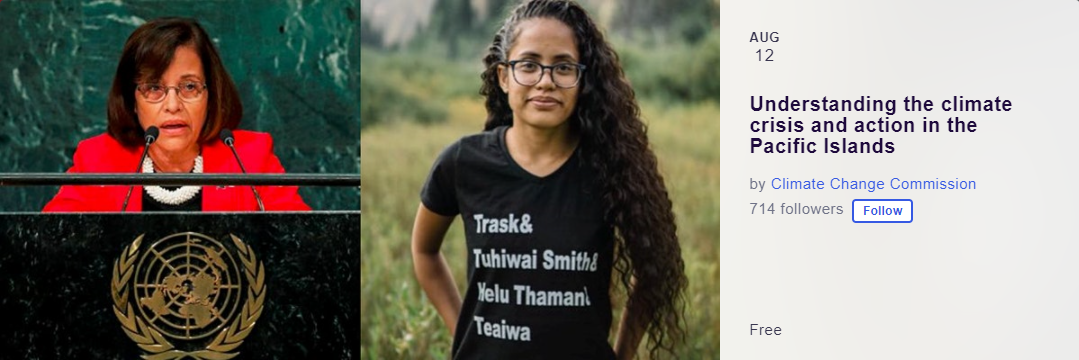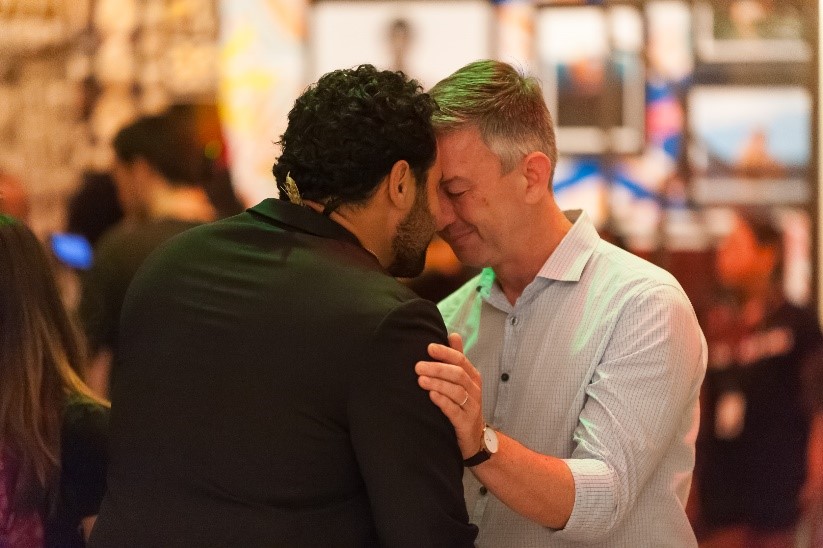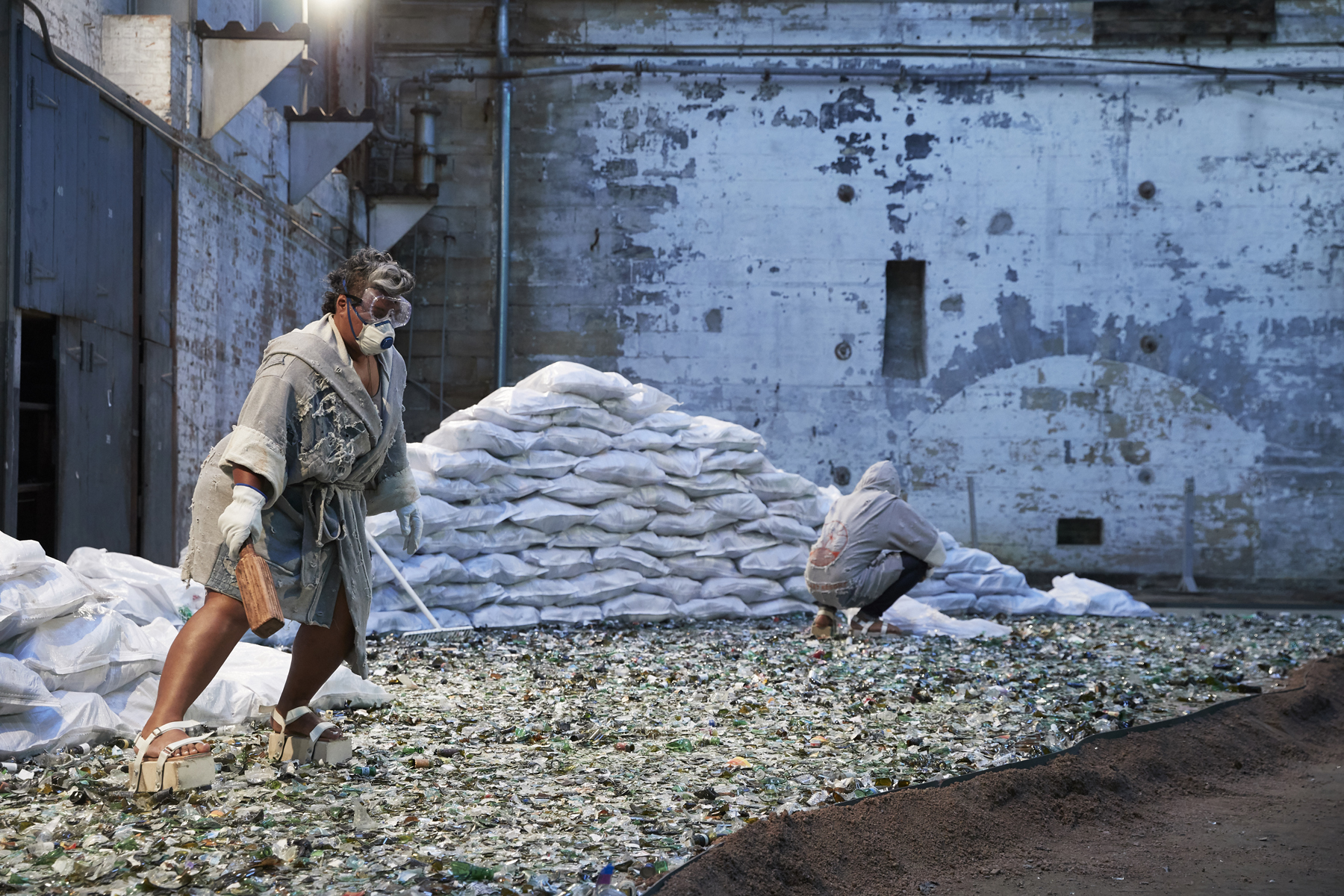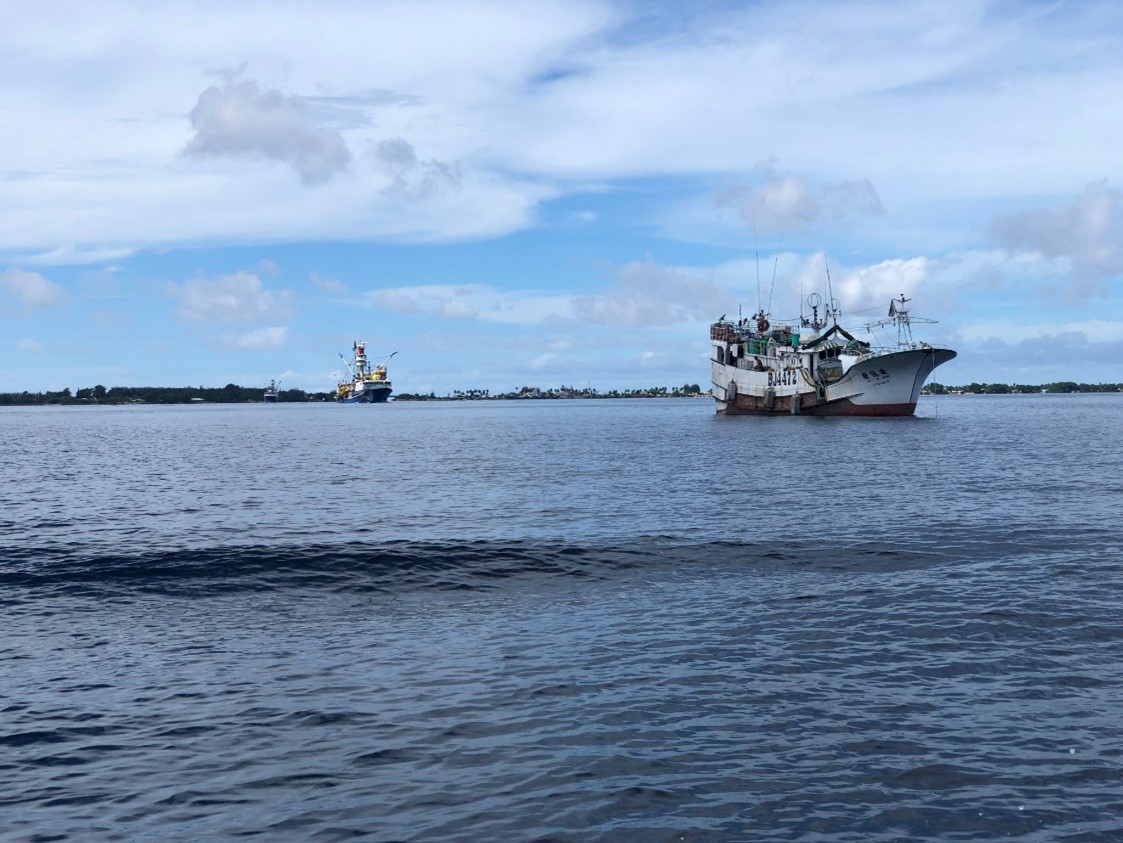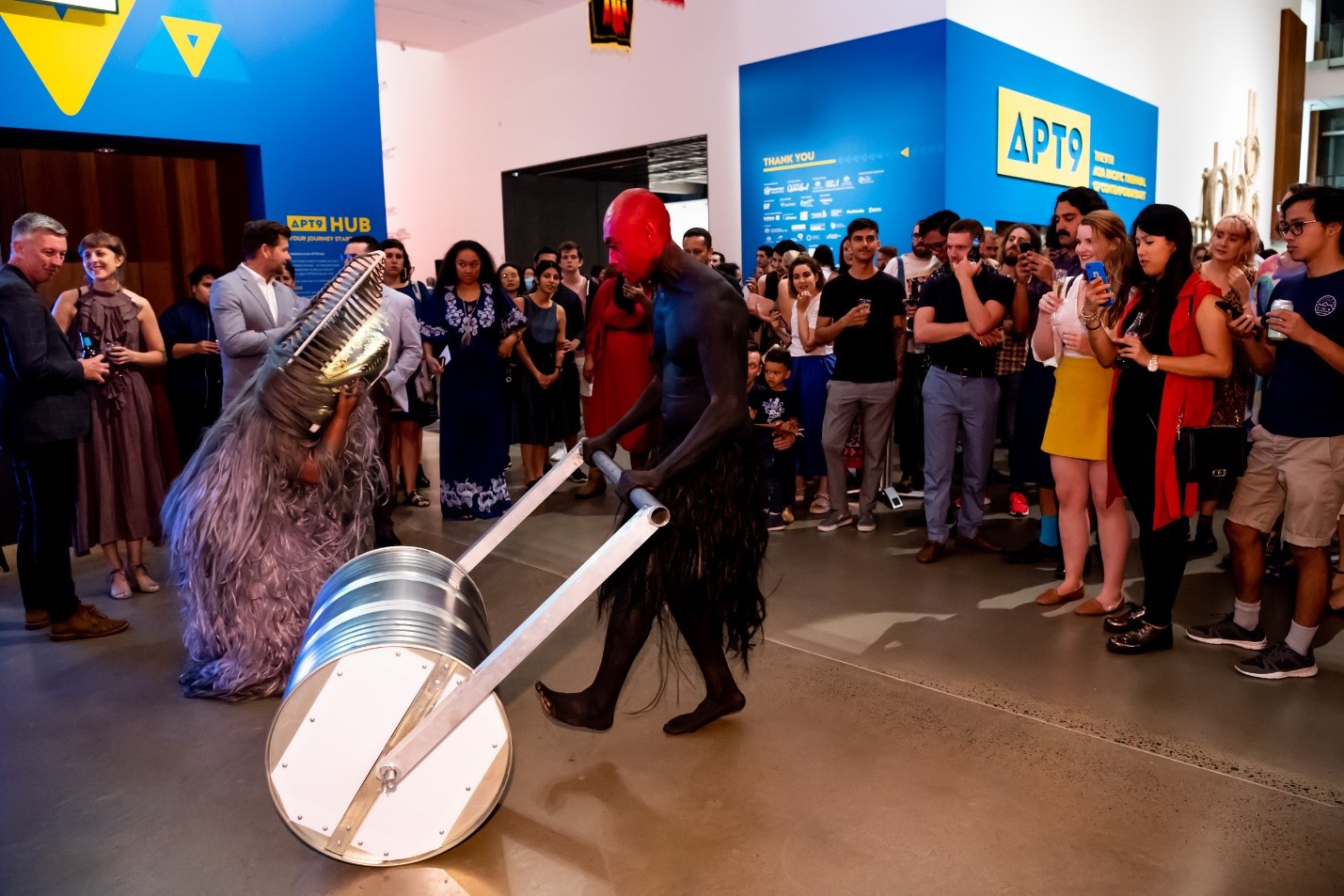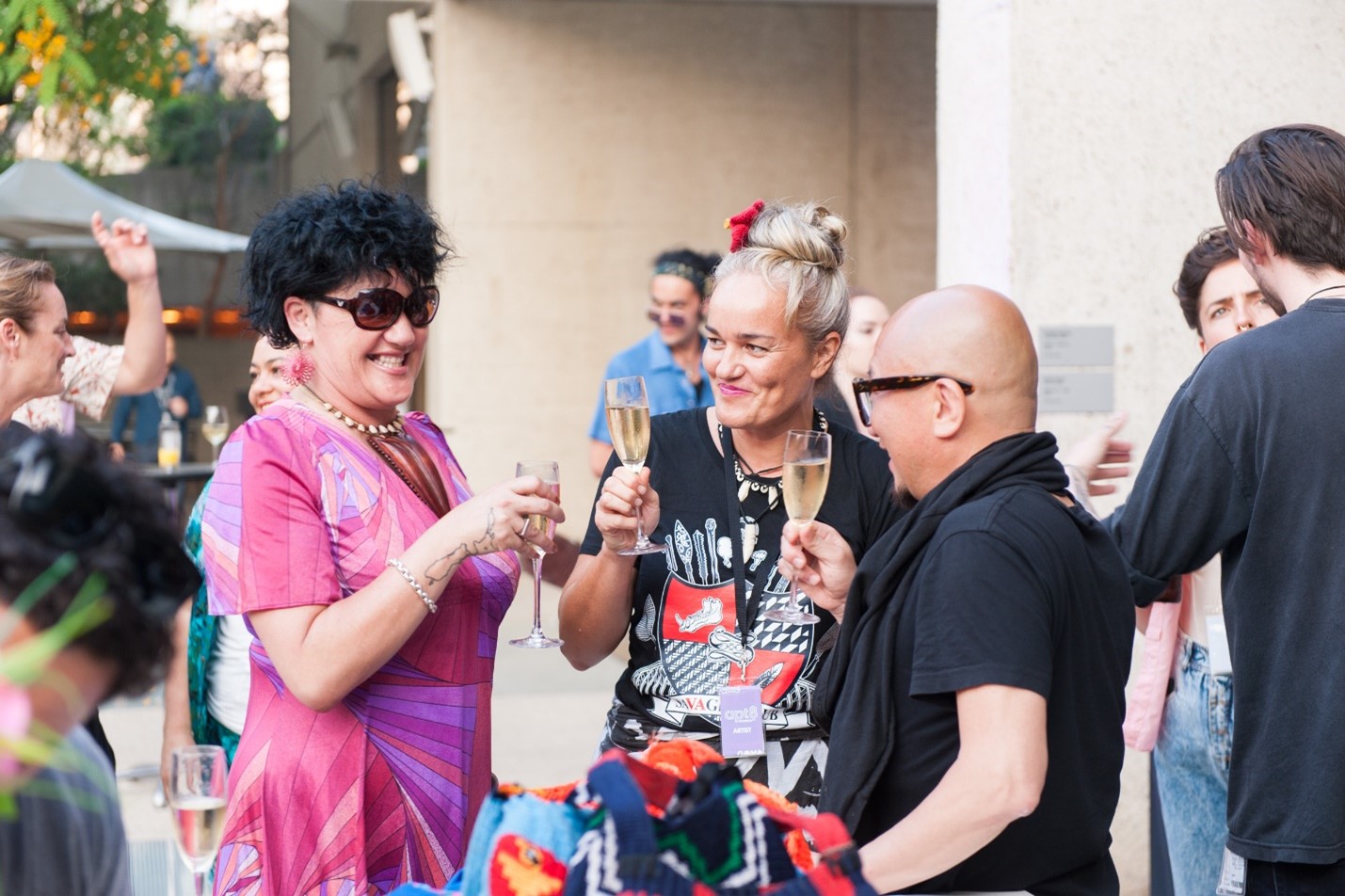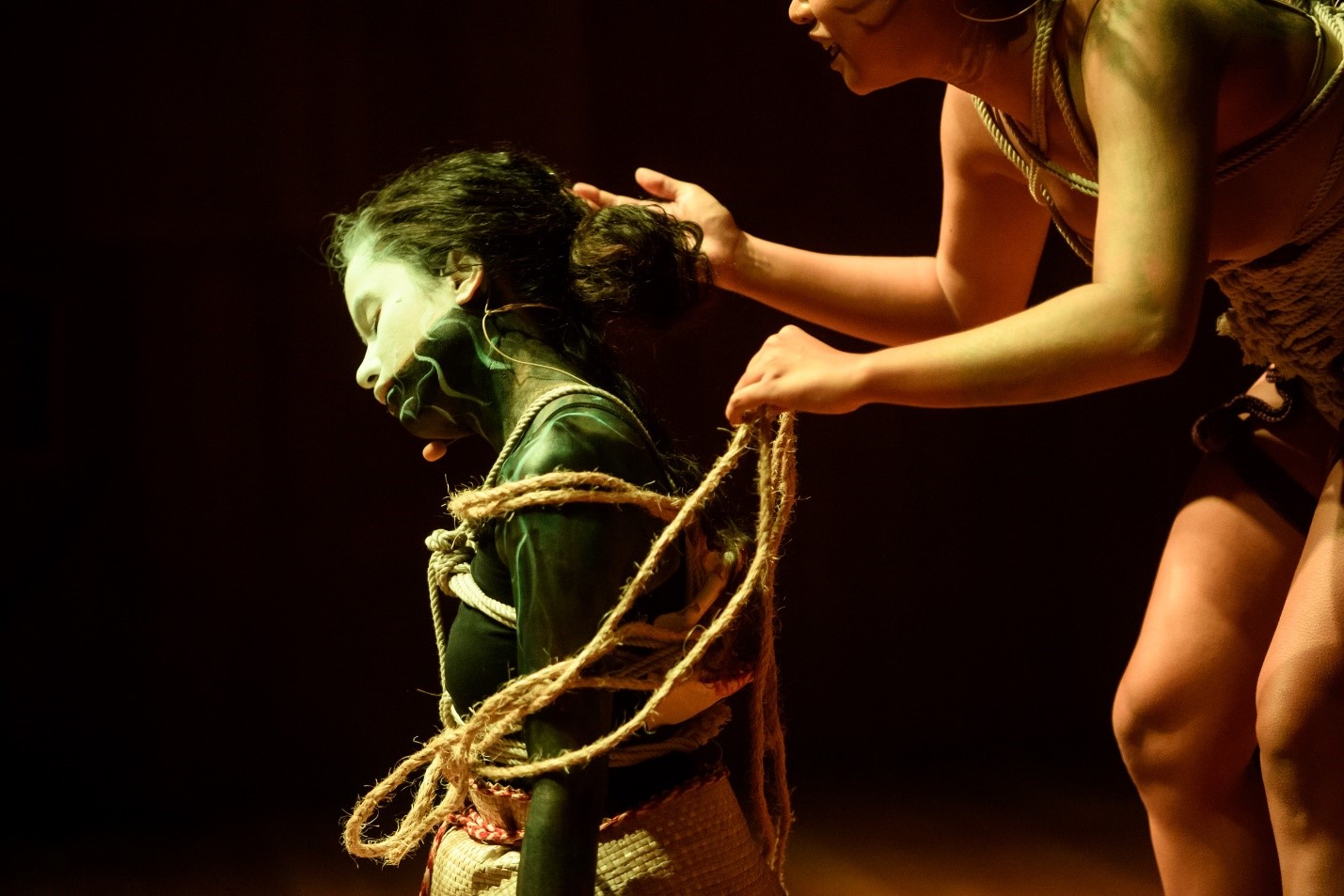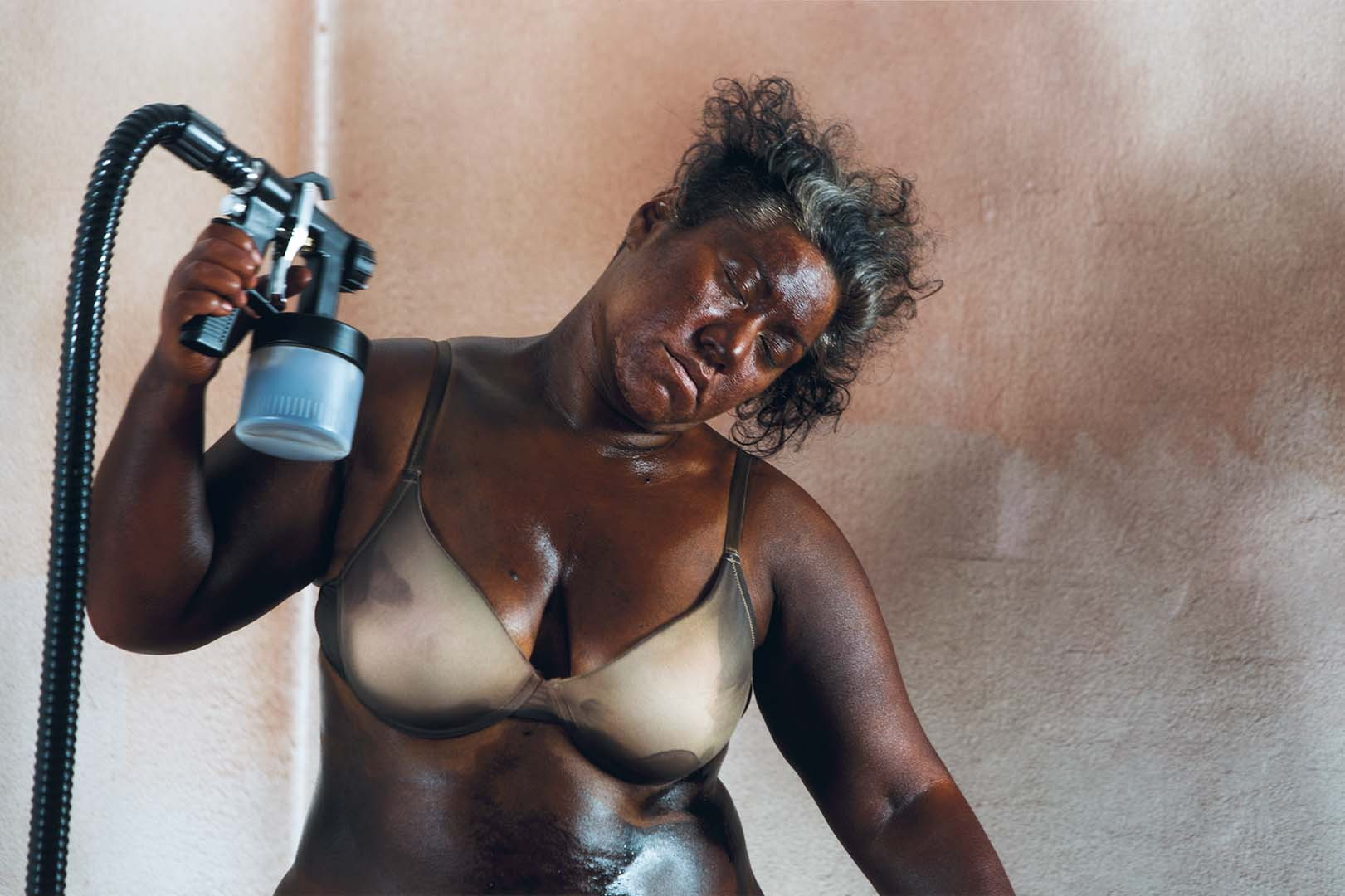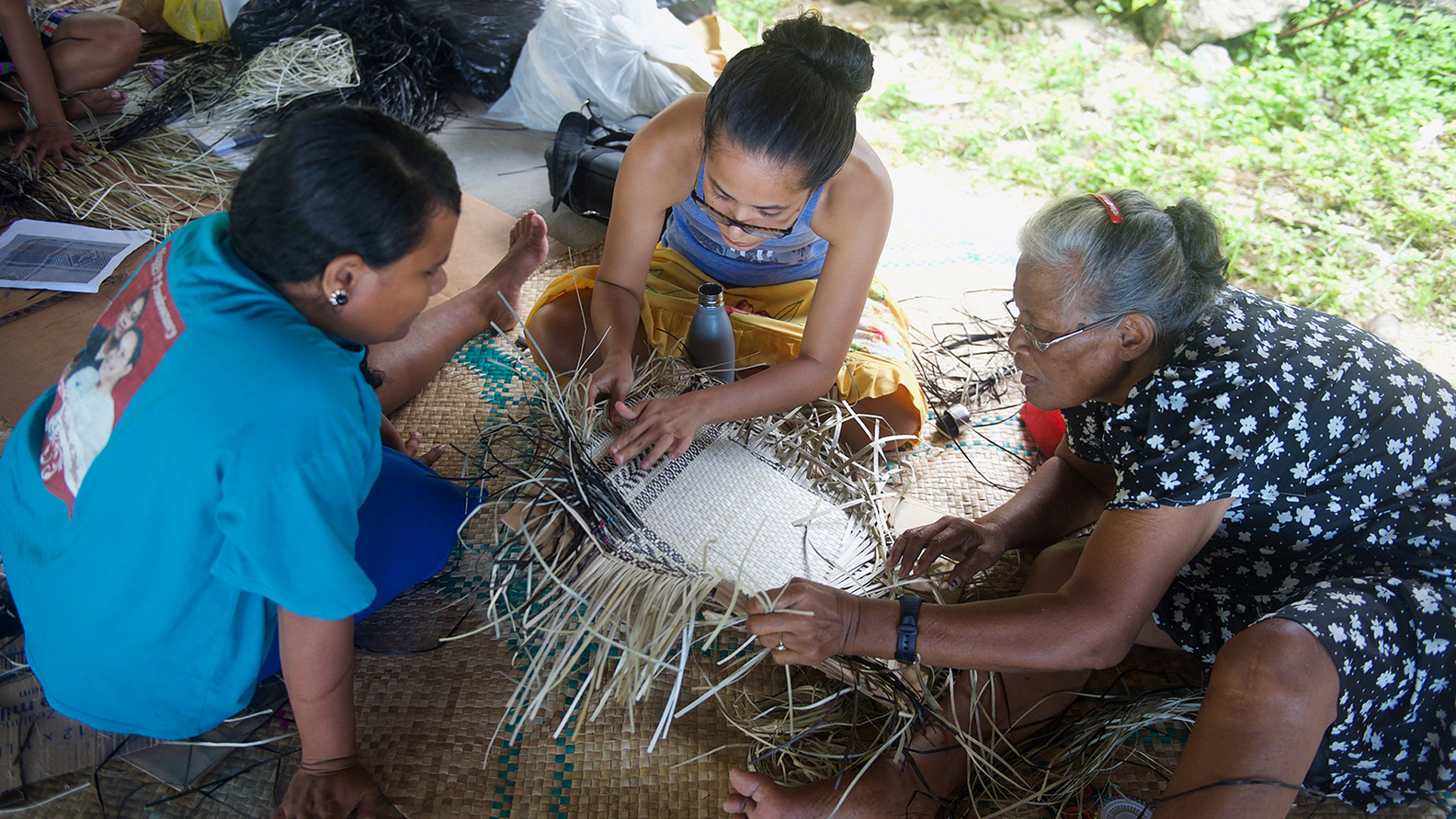Roundtable
In the ha: Cultural activism in the Pacific
Rosanna Raymond (RR): I’ve been hammered. I did five back-to-back Zooms the other day. Everybody’s talking about the COVID pivot and how to do this. The [forthcoming] Aussie live works, Latai and I have postponed until next year for a physical [performance].
Latai Taumoepeau (LT): We’re refusing, I’m refusing, to take some things online. They just can’t — it’s a two-year project and we’re just going to have to start next year.
RR: It’s good. It’s actually interesting to see the institutions that are being more nimble with what I kept calling ‘the elasticity of time’, instead of ‘We said we were going to do it on the 14th of October so therefore you have to do it’. Navigators didn’t do that. If there was a big storm, you didn’t leave.
LT: Exactly.
RR: You read the wind and you read the stars and you waited for a more appropriate time. It didn’t matter if you said you were going to leave on that day. So yeah, I’m getting quite interested in really looking at how relationships are at the heart of projects rather than the spectacle or the end product. For me, it’s pointing out who really does work in the arts. I’m enjoying that. It’s just trying to earn a living in between that … [laughs]
LT: Yeah. You know, this is our twelfth or maybe even thirteenth week of lockdown; it’s been really interesting to spend time accessing the knowledge systems that exist among our scholars, because they’ve put everything online. I have spent heaps of time sitting in lectures and talks. I even attended a talk that Kathy and her mum did a few weeks ago. For me, the fluidity in the way that we are exchanging information in our region online — which people from disability cultures and communities have been doing for a long, long time, and we’re kind of catching up on — has been really, really amazing and really generous.
RR: That is interesting. Yes, I managed to do a lot of that the first lockdown … Kathy, what have you been doing?
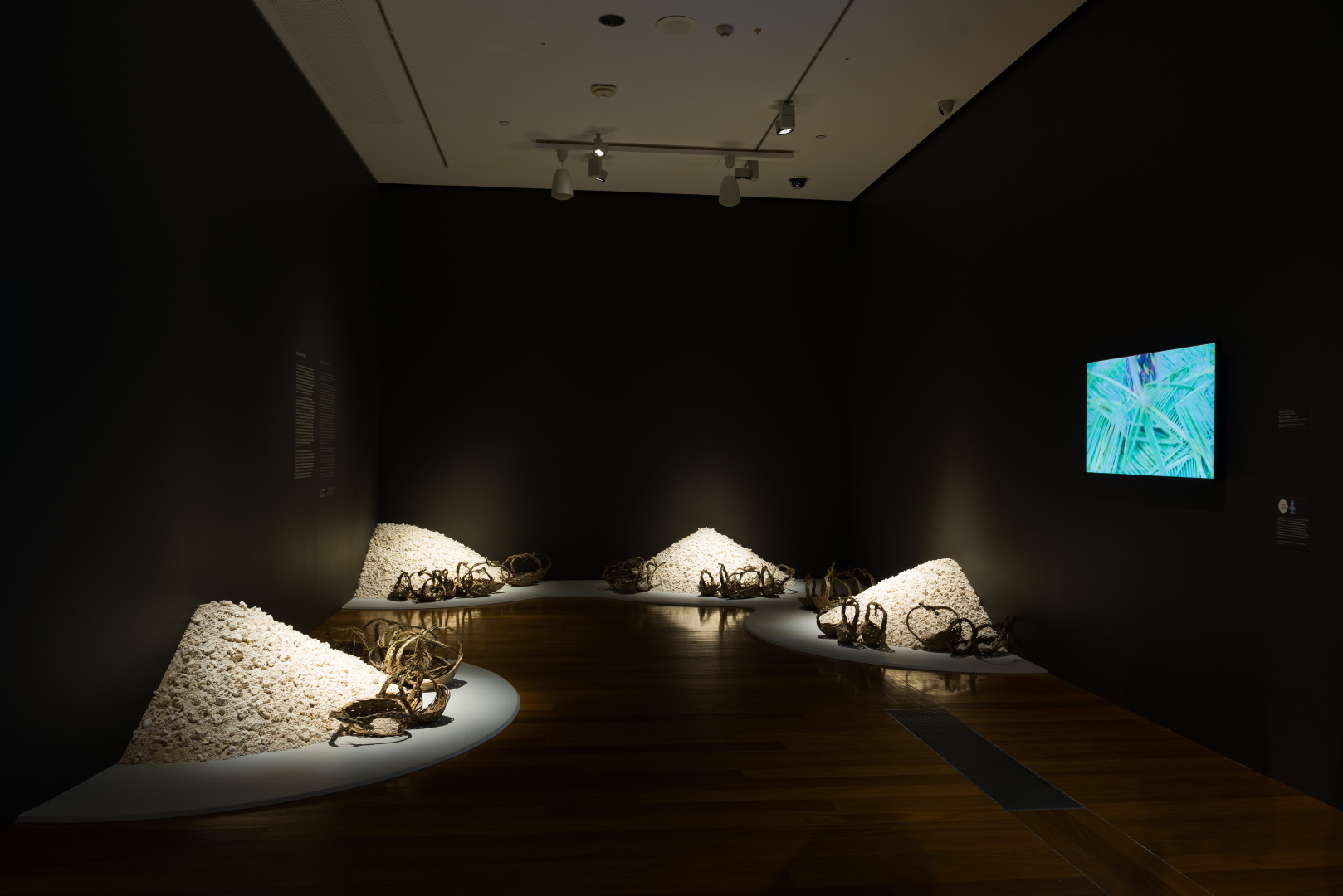 Kathy Jetn̄il-Kijiner / Eorak for Section 177 2021 (installation view) / Single-channel video: 16:9, colour, sound, MP3 poem: 1:50 minutes (looped); coral and woven coconut leaf / Dimensions variable / Commissioned for APT10. Purchased 2022 with funds from the Oceania Women’s Fund through the QAGOMA Foundation / © Kathy Jetn̄il-Kijiner / Photograph: Natasha Harth
Kathy Jetn̄il-Kijiner / Eorak for Section 177 2021 (installation view) / Single-channel video: 16:9, colour, sound, MP3 poem: 1:50 minutes (looped); coral and woven coconut leaf / Dimensions variable / Commissioned for APT10. Purchased 2022 with funds from the Oceania Women’s Fund through the QAGOMA Foundation / © Kathy Jetn̄il-Kijiner / Photograph: Natasha HarthKathy Jetñil-Kijiner (KJ): Just work. different types of work. I was finishing up my poem for my art installation for APT10 yesterday — an audio recording. It’s crazy to hear that you guys have been in lockdown for that long. Out here in the Marshall Islands we haven’t had a lockdown. We still haven’t had COVID. In a way the whole island is locked down, I guess, but we can move around. It’s a weird position to be in — to sort of be stuck on the island and not able to travel out at all, but then also seeing everything that’s really horrific happening everywhere else. I think we’re okay for the most part but just witnessing everything happening around you is kind of scary.
RR: Yes.
KJ: Otherwise, we’ve just been really busy with lots of coordination We’re heading into our compact negotiations — which is a treaty that the Marshall Islands have with the United States — and helping to coordinate the climate proposal and how we would incorporate climate change into our compact negotiations. It’s a steep learning curve. It’s also interesting to hear you talk so generously about all these things online — we are doing stuff online. I was just on another ministerial call last night for climate change, but there is also still so much happening here with funerals and gamins and picnics and things like that. I feel like I should be writing about COVID. But I don’t have the presence of mind now to write that much.
RR: This has definitely put me in a different space, and I realised I’m only just managing the present at the moment. I’m not very good at the future, and yet a lot of the work demands that of us. We’re having to constantly forecast into the future and try and renegotiate and pivot and find new language and all these new ways and new learning and it’s a little bit overwhelming. In terms of the roundtable, the activism — it’s interesting to think through some of that stuff online where I’ve just completely withdrawn. Yet I’m trying to struggle with the language of what it’s like. There’re lots of things I’ve seen online with ritual and stuff, but I keep thinking what is actually missing is this ha — this direct exchange of breath — and that’s why Latai and I decided, no, we have to do it live. The online is one aspect, and you can do heaps on it, but it still hasn’t got the depth and for me it’s in the ha.
LT: I understand exactly what you mean — the physicalisation of that energy transferred to another being — but I can’t help but think about who I become when someone is jogging in front of me and I feel the aerosol — stepping into the COVID aerosol. These are the things I’ve been thinking about as well: what it means to be face-to-face and what it means to share that breath and that exchange of energy, and then the extension of that is love through shared breath and exchange of breath.
RR: I know — that has hit me really hard. Walking down the street now air can kill us. This is the world we live in now’. We have done this. It’s like, never mind the conspiracy theories and 5G and all that: bottom line is we have destroyed the very air we breathe.
LT: Exactly — especially with the IPCC report released a couple of weeks ago. It is a devastating read, but about things that we already know. For many people, the way they experienced climate change used to be at a distance; as something that is over there. But now it’s in our faces. It’s in our breath. I don’t separate the pandemic from the destruction of the planet. We’ve extracted everything and it’s poisoned our air. We’ve deforested huge amounts of land — the filters. We’ve destroyed all these things. So, I think we’re eliminating ourselves from the natural world and that cycle. We are facing an existential threat and it’s unbelievable — yes, no work can happen except for looking after ourselves. That’s really all that can happen. it just blows me away. I try not to overthink it but look at Fiji: it’s just unbelievable what they’re experiencing. Do they have the infrastructure to deal with it?
I wonder about Tonga’s infrastructure. Fortunately, like you folks, Kathy, they don’t have COVID there yet, but I’m looking at the way we are experiencing it here in New South Wales and the other states holding on to keeping as much of it out as possible, and keeping control of it and then watching you folks and thinking, wow, the preparation needs to happen for our Pacific nations where everyone just resets, gets vaccinated, has the game plan ready — because once this variant hits, it’s relentless. It’s an mRNA virus, so it mutates constantly. Once we think we’re going to have a handle on it — on one variant of it — we also may have other variants appear and, for me, when I think about all the island nations, I don’t think they can cope.
KJ: That’s why they’re not opening up at all. That’s being discussed at COP — the United Nations climate conference — right now … You know, Pacific representation at COP is always low. We’re always outnumbered, out-manned, out-gunned, basically. And now with COVID, all of our islands are blocked off and the question becomes: ‘Are you going to risk your island’s safety to go out to COP to talk about climate change right now?’ And in some ways, it’s like, yes, because it’s worse than we thought now. The IPCC report said that we [will be] surpassing 1.5
degrees in 20 years.
LT: Twenty years …
KJ: Twenty years. 2040. It’s not that we’re reaching 1.5 — we’re surpassing it. Here in the Marshall Islands — at least those of us who’ve been doing climate work — we have a really close relationship to that number and how important it is. Basically, in the climate debates it is 1.5 versus 2 degrees. I was at a communications climate conference where somebody from the UN said, ‘There’s no way anybody is going to go for 1.5, because 1.5 is unreachable. It’s asking for too much from the other nations. They’re not going to agree to limiting our temperature by one-point-five.’
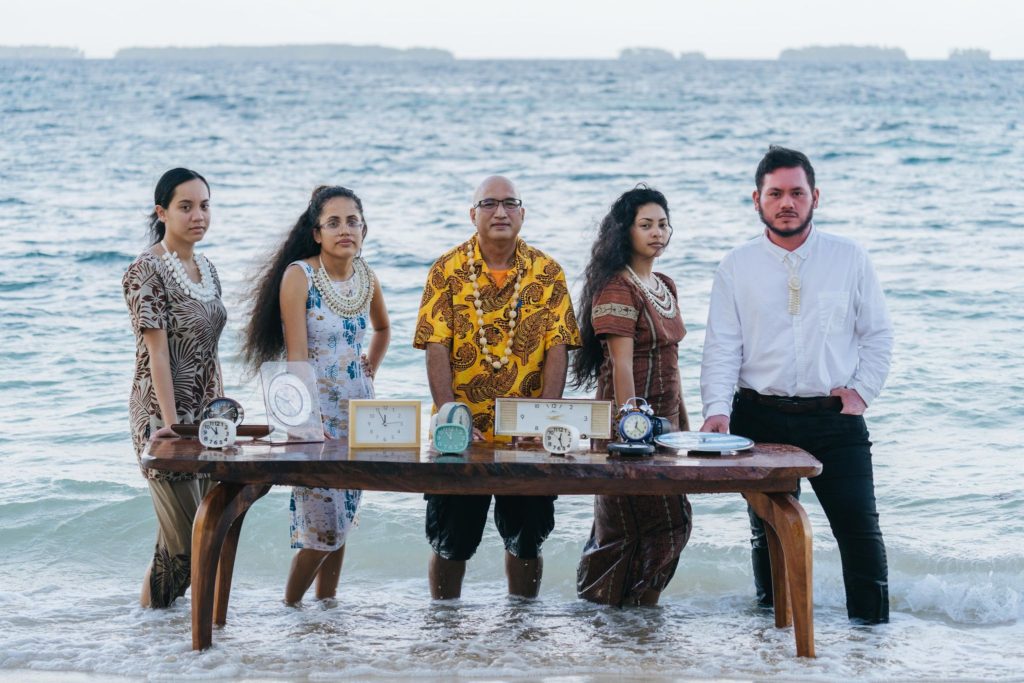 Kathy Jetn̄il-Kijiner / Midnight 2020 (still) / Single-channel video: colour, sound, MP3 poem: 3:16 / Commissioned for 'Fighting for Our Survival' series by Pacific Climate Warriors, 350.org, The Climate Vulnerable Forum, Agam Agenda, and the Institute for Climate and Sustainable Cities / Image courtesy: The artist
Kathy Jetn̄il-Kijiner / Midnight 2020 (still) / Single-channel video: colour, sound, MP3 poem: 3:16 / Commissioned for 'Fighting for Our Survival' series by Pacific Climate Warriors, 350.org, The Climate Vulnerable Forum, Agam Agenda, and the Institute for Climate and Sustainable Cities / Image courtesy: The artist KJ: He told me that point-blank to my face I was like: ‘But 1.5 is our safety. That’s our threshold.’ So, I wrote a poem about it, because it sounds so small: 1.5 versus 2 degrees. And the line I used was: ‘1.5 must sound more like crumbs on a map. Luckily islands must look … on a map, just crumbs you got on the table.’ So, to see 1.5 … there on the report and that we’re definitely passing it. Even our youth went out in protest — it was the first time I’d ever seen Marshallese youth campaigning about 1.5, and the reason I’m explaining this is because we have to tell the public. It got to the point where somebody spray-painted: ‘1.5 to stay alive’.
RR: Wow.
KJ: That was the hashtag that the youth used in the social media campaign.
LT: Ten years ago, that was the slogan — and it’s crazy because when we do hit 1.5, reversing is not possible. When you calculate the years your children have and you think about where we’re going to be in that ten years. Unbearable temperatures in 20 years. It’s crazy, not only the Pacific — Maldives, the Caribbean. They’ve been campaigning on that for a long time. We’re beyond being polite about it. It’s like when you and your mum were talking about how we’re done with mitigation. We have to adapt, but also, we’re not leaving, and that is a really important thing. Where is all the innovation going to come from to ensure that people can remain in their ancestral homelands? Because without our island homes, who are we? Who are we going to be without those places?
RR: Yes, it all gets a little bit overwhelming. I noticed, even when I was in the Cook Islands, that so many of the local people have left, because basically the region has relied on tourism and that’s gone now. The loss of people was palpable.
KJ: I don’t want to leave.
LT: I think, for me, my practice changed about two years ago, and the shift was quite cathartic and about my own homeland. Because it will be submerged eventually, I wondered: what am I doing here [in Australia]? I should leave at least once in my lifetime. Thinking about how I received that idea of belonging to a place through my grandparents and through my genealogy, and just travelling back and forth, really makes me sad for our future generations. That’s mainly what it is for me, and the point of some of the works that I’ve made is that they are my legacy. They’re evidence to the next generation: I gave a shit. I cared about you. I really wanted to make things that show that. I’m embarrassed for us for future generations. I really am.
KJ: But it wasn’t our fault. We didn’t do it. It’s definitely not our countries or our communities. It’s definitely the first-world nations, billionaires, corporations …
RR: It’s quite interesting. Especially, I’ve found, in New Zealand lately — with the sort of politics addressing where the pollution issues stem from. Freshwater swimming is a thing of the past now. When I grew up, I could jump in the river anywhere; not now, because of the whole intensification of farming. People started to go, ‘It’s the cows’ fault, because they’re all farting too much’, so then all the farmers were getting hated on, and now they are doing things to get our carbon footprint down. You won’t be able to have backyard barbecues anymore because of the effects — so the little guy pays again. What about the big guys?
KJ: We heard that the concept of carbon footprint was invented by the fossil fuel industry, right? Oil invented it to shift the burden onto the individual.1
RR: It’s worked.
LT: It’s totally worked.
KJ: People don’t like climate activists because they think we’re all trying to
take away their ACs and their cars.
RR: Yes, and their barbecues.
KJ: I enjoy those too.
LT: It’s totally worked, but I think that’s also why it has become really important for people to understand how other political movements that they can engage in are important too. I mean, Tongans in Tonga say their idea of action is based on exactly what you’re talking about, Kathy: the guilt that the fossil-fuel industry has put on us and what are we doing. It’s about plastic. No, it’s about fossil fuels and lot of other things that we can do more effectively. Like, divest your money out of the big four banks who loan and finance the fossil fuel industry.
KJ: We had a newspaper editorial out here before the IPCC report came out — it was a month ago — that noted we’re seeing all these things happen around the world, all this devastation and destruction. Should we even be calling ourselves the frontline victims anymore? The climate team needs to change their messaging, because we’re no longer the most vulnerable in the world. I was like, ‘What is this? The vulnerability Olympics?’ This is totally ridiculous. At least other places know they have somewhere they can go. We don’t have anywhere to go after this, and they’re looking at the absence of destruction as this sinister slow onset. Yes, it’s easy to place blame on ourselves, basically. I can empathise with those in Tonga. We’re trying to attack both sides of the issue, and say, ‘Look, we’re doing the work here to show that we’re doing the work ourselves’. It reminds me, you know, when the black activists talk about how they were raised to speak perfectly, to dress perfectly, because it made them less suspect. It felt similar to that, where we’re making ourselves as perfect as possible. Look at our mitigation! Look at us switching to 100 per cent renewable energy! We’re doing all the work here, so that people will listen to us. But at the end of the day, our contribution is negligible. I mean, point-zero-zero-zero-zero-zero-one per cent of the world’s global emissions. We could be the most energy-efficient country in the entire world, and it won’t do anything to keep us above water. So, it’s really frustrating to me to know that. I don’t know how to convince people of that, because the common blowback from people when we talk to them about climate change is, ‘But what are we doing? What are we doing? We’re still using motorboats?’
RR: [laughs] Yes, you guys are still fishing! Meanwhile, [Chinese commercial fishing] has killed off most of our sharks. There is that top-heavy sort of pyramid. It’s frustrating. I think I’m feeling a little bit like an old soldier. Recently, I was doing some work with Tautai and younger artists. There’s still a lot of pain and anguish in identity — that feeling of, ‘I was born here, but am half of this, but I’m not this’.
KJ: Is it for real?
RR: I’m like, ‘God, that was the same 30 years ago’. So what hasn’t changed or what message hasn’t come through? That’s three generations now and they’re still facing the same shit — the pollution. I am of the generation who wanted to ‘save the whales’. It’s so bloody exhausting.
LT: Yes. But that’s why it’s so hard to separate the environmental movement from colonisation. And green imperialism is so real. You know, it’s such a mess — doing what you can to be self-sufficient and just minimising extraction is the way. That is where my practice is headed. I’m not going to self-extract for this dumb-ass arts world as well. That parallel extraction. I’m not going to be complicit in that either in my practice. Not doing that.
And these things need to come together a lot more. I have a Great Uncle, Loloma Mata’ele, who was an artist and was a part of a movement. He’s passed away now, but he was considered quite mad. He would do these paintings in the village with whatever materials he had, and he was writing letters to all the world leaders about the whales — and how important the whales are. One of his best friends, who was with Greenpeace at the time, approached the King of Tonga. That led to the ban of all whaling. And I feel like that mad person who advocated for things. We need to do things! I just need to do my thing and hope that it radiates to other people who are doing their things, like you. And I just have to find some satisfaction in that action.
But I think the thing is when artists lead these kinds of actions … we have a way of approaching discomfort, disadvantage, hard times that’s forged in creativity — that actually enables something more. I feel like that’s the importance of working, collaborating and having conversations and being face-to-face with other artists. It’s that ability to see beyond the hardship and find ways of doing things. You know, just like that old man, my uncle.
I always have these ideas of intergenerational connection: there are always people that just continue that work. You continue on with that work — that work for your land, for your place, which people are part of. All of those things. So I just want to be that little grain of compost that is a part of the continuation of place. That’s pretty much it. I think that’s all I want to do from now on.
RR: Tame Iti [a Tūhoe Māori activist] always understood the theatre of garments and wardrobe. Of course, in New Zealand, we’re all great T-shirt wearers. It’s definitely one of my favourite ways of bringing messages across. It probably was at least 25 years ago when all the T-shirts started coming out of the South Side. The South Aucklanders were creating presence and it’s sort of grown now. No project worth its salt doesn’t have T-shirts. SaVAge K’lub definitely took on the T-shirt — but actually, that came from the Pacific Sisters. We used to make our own T-shirts as well, just because you couldn’t find them represented anywhere else. I say this in my best adidas leopard-print T-shirt today … So what am I saying?
LT: I know: I love adidas myself, but actually I’ve tried to stop buying clothes and just wear whatever I have and also maybe second-hand. But also wear what some designers who I’m very close with make. Because a lot of them repurpose remnants of fabric. But it’s very difficult because I like a good look. So, what I’ve started doing with my last work that I just finished a few weeks back — where there’s a little bit of costuming budget — I try and get things that I will wear again. it comes down to fabric choices and things like that, because you do think, ‘What am I going to do? What is my little contribution?’
I guess it’s just whatever changes that you can make and, with the bigger issues, it becomes more and more difficult. So, I think for me, certain divestment programs help me feel like I’m being the activist that I want to be.
That’s not always inside my work. Activism, to me, is about systemic change. And I think when you’re a person of colour inside the dominant colonial-settler structure, which we’ve all existed inside — or we all mostly exist inside — just being is challenging. Just existing in public space is challenging. So, I think whether it’s your skin colour, your physical attributes, your gender or your clothing — I see those as opportunities to have an identity or a voice, or to convey where you think things should be in the world.
LT: I remember several years ago stopping at a supermarket on my way home to pick up things for dinner and suddenly being followed around in the shops by security. And it’s like, man, it’s just the end of my day. I’m trying to go home and now I’m being suspected of theft. So that really, really agitated me so much that I just thought, you know what? If you want to watch me, I’m going to give you something to watch.
I read a bell hooks book, so long ago, called Killing Rage, talking about racism in the context of the effect of it on people of colour — you end up with the rage and you don’t have anywhere to put it. So, I just thought no way, I’m not taking this home, man. I’m leaving it here in the supermarket. So, I just pushed the trolley super, super slow and I just went through the structure of different choreographic tools, working with speed, working with levels. Then I had this problem that nobody knew it was a performance, so it wasn’t really a performance. So, what I ended up doing was finding a moment to be still and freeze in space for a certain amount of time while I processed it, and then I remembered social media.
I checked in to the supermarket on my phone and then I took a photograph of the person that was following me. I wrote about it, and then I posted it with the photo, with the check-in. Because then it made it public. Then, after I pressed submit, I realised this performance was finished. I took the things out of the trolley that I wanted — which was literally three things — I purchased them and I left. I was like yeah, leaving this racism behind; I’m not taking this home with me. I felt like the discipline I belonged to really served me. I learnt something really important. I thought, why should my physicality or my colour be the only thing that determines my identity for somebody else? It’s one of my most enjoyable performances — that, to me, was a feeling of activism.
RR: You actually triggered loads of memories for me as a kid. Especially as a young teenager, I could never figure out why I got followed all the time in supermarkets and stuff. When I first noticed it was in Christchurch in the 1980s. I realise the damage it did over the years, because I’m just always constantly looking over my shoulder.
I always hunched. It’s taken me years to try and actually stand up straight. It’s literally in the last 15 years that I’ve really tried to be that guy, rather than that guy that can’t be seen.
LT: The context that we exist in is the same as the context that we create our work in, you know? The everyday blurs into the surreal professional sectors that we find ourselves in some days. You just hope that you end up saying or doing something clever in those moments.
Whether you wear the things or speak the language, you are that person and that is more than enough. These constructs can be important, because just existing within these systems is being an activist in a particular way. When you break it all down, even growing food for your own consumption is about responding to the world right now, is about going back to the ways that our people have always known, our ancestors have always practised. It’s the practice within the practice. That writing practice inside that other writing practice. It’s all of those things that we embody already, and how we kind of reframe it and repackage it about the things that are important to us, and that are valuable, that is important. Because it’s our voice.
The problem is there’s not enough of our voice in some of these big issues that impact us first.
KJ: Yeah.
LT: That’s the importance of the activism that we are performing inside our forms, inside the cultures that we exist in. Because it’s the voice of our region, the voice of our ocean. The important thing is that it happens in so many ways right now, because time is running out. It’s like when you were talking before about how, if you live on the islands, you just don’t relate to this form of protest. Just be you. Just do what you’re doing. It’s that thing of … what’s the responsibility of diaspora? It just needs to exist in all its multiple forms, you know? I think that it really doesn’t matter. I call myself an anti-disciplinary artist now. If it’s video, if it’s poetry, if it’s walking. I don’t even care anymore. It’s like those forms, they’re not going to limit the work that needs to be done. It’s just that simple.
When you look at certain things in the region, it is really important how we all learn from each other. The year of COVID lockdown saw all the scholars online. I was online all the time watching Pacific Island lecturers giving all this amazing information. Just looking at the resurgence of navigation and seafaring with Mau [grandmaster navigator Pius ‘Mau’ Pialug, 1932–2010] in Hawai’i, and it just sparked everybody to think — oh, let’s all get back into this.
I find, as a Tongan person in Australia, that when I’m hanging out with other indigenous people and First Nations people from here, the activation is in memory. When indigenous peoples talk to one another, it creates a collective remembering; this kind of activation is how we are rebuilding, reconstructing ourselves inside a foreign system. But inside our region, you know? It’s like as we continue to remember the things from the past together — it’s like a collective memory, right?
KJ: When you talk about voyaging and the different islands learning from each other, it’s a bit of a loaded topic for me personally because Mau is Yapese — he came from [the island of Satawal, in Yap State] Micronesia — and he went out and taught Nainoa Thompson these ancient skills of navigation, right? But he taught him at a very high price. A lot of his village shunned him for sharing that information.
RR: Yeah.
KJ: And there was a lot of resentment from the Micronesian community in Hawai’i. I’m not sure if you’re aware of how much racism Micronesians experience in Hawai’i, from other Hawaiians and also from the locals. There was some kind of reckoning, where even I had to call out Nainoa. We had a call recently to discuss the issues of the Micronesian countries exiting the Pacific Island Forum (PIF). I don’t know if you saw that?
RR: Yeah, I saw it.
KJ: Micronesia left PIF because the Micronesian candidate wasn’t recognised. So, in this call, we’re hearing from all these people saying, ‘What happened? This is such a big rift’. Like mourning this thing that’s happened in Oceania, and Oceania has split. I came in hella hot and fast, being like, actually, I feel really proud of our leaders for standing strong and exiting — you know, mostly in Hawai’i but also in Guam there is this very north Pacific issue of Micronesians feeling sort of silenced and feeling left out of conversations. I’ve experienced it at a micro-level in high schools with other Pacific Islanders: in the ways in which Micronesia is literally physically smaller as an island but also as a people. And then also physically, in comparison to Polynesians.
Then having these conversations about [how] we are one, we are Oceania, and struggling with that a little bit. Then when PIF happened, and we were having this call with Nainoa, I was the one coming in like, actually, I’m really proud of us for standing our ground, and leaving PIF, and saying, look — we’re not going to let this happen again when we haven’t had our voices heard. And, to Nainoa, I really think you could do more for the Micronesian community in Hawai’i.
For me, it’s been a very interesting time to be Micronesian this past six months. Micronesia left the Pacific Island Forum, a Micronesian boy was murdered by the police in Honolulu, and then a Micronesian woman reached the deepest part of the ocean. She was the first Micronesian, first Pacific Islander, second-youngest person to reach the deepest part of the ocean in the Marianas Trench; her name is Nicole Yamase. There was an article that came out about it, saying she’s Pacific Islander. And she made a statement to say hey, ‘I actually identify as Micronesian first.’
LT: I want to hear more about that; I think it’s so important.
RR: Yeah.
KJ: I would love to hear a little bit more from you guys, too, about how you experience that. Because there’s this idea of Oceania that I love and I really buy into. I got my Masters in Pacific Island Studies. I’m doing my PhD in Pacific Island Studies. And yet there’re so many ways in which, as a Micronesian, I feel left out. I feel like Oceania has let me down in some ways, sometimes. And so, I sort of want to delve into that further.
LT: That’s why I think the frame of activism is really important, actually. it’s important to unpack that as the main focus that binds all of us together.
RR: My son has grown up with this creative community that I’ve always sat in, and he’s absorbed all of that. Just watching him make choices about how he buys food or how he consumes — he’s kept that curiosity, even though he is the whitest Samoan you’re ever going to meet in your whole life.
We’re in the Cook Islands: there was this whole different realisation in his body about being an islander. I keep saying, ‘Going to the Cook Islands, you can be an islander, but you don’t have to be a Samoan’. It’s a completely different experience because you haven’t got as many responsibilities … but it’s still enough to get into the genealogy at that molecular level.
LT: You know, I remember, when I met Salvador, Ro’s son. My sister and I were there working on the Whales Alive project, because the International Whaling Commission was happening in London and we connected with Ro. Salvador wrote this beautiful poem that he read out at this event that we had organised to amp up Pacific Island support at the conference.
RR: He would’ve been ten.
LT: He was young.
RR: He’s now 29. [laughs]
LT: The other day, I saw a little clip of Sal playing a bone instrument online. I just remembered when Sal was standing there as a child reading this poem that he had written about the whales. It was so, so beautiful; your connection to place and the environment is something that happens intergenerationally. It happens in all sorts of ways in all sorts of places. That to me is an archipelagic logic.
RR: Hello! You spell that, girl! Can you spell that? [laughs]
Kathy Jetñil-Kijiner addresses the Climate Summit at United Nations Headquarters in New York, 23 September 2014
LT: That’s why, when you read your poem at the UN, Kathy, to your baby daughter — that was one of the most moving moments, because it is that saying we defend our place and our body through our generations. I was so moved by that. It went viral.
KJ: Yes, that was crazy. It’s funny, because someone was just asking her how she feels about it. She’s seven now and she was like, ‘What’s the UN?’
RR: Fantastic, hey? We’re all deep and meaningful and they’re like, ‘What? Whatevs.’
KJ: Totally, yes. It’s so funny to be around kids and see the way they’re just in constant motion and creation. I don’t know — I have written about motherhood, but not just motherhood on its own. It’s always motherhood in the context of climate change or the context of nuclear justice. It’s never just a meditation on motherhood standing on its own two feet and I’ve wondered … I’m so focused all the time on Issues — the capital ‘I’ — and I don’t know, I feel like the poetry that I gravitate towards lately and that I’ve been really moved by are just life. They’re just reflections and a meditation on life and that’s it. I haven’t really taken the time to do that, because there’s all these other big issues. How am I going to sit around and think about life? I want to, though. I feel like it will help with my art and my writing if I take a breather from all of this other stuff that I’m doing. It’s difficult.
LT: Yes.
RR: That’s a really vital, vital thing to recognise: that need, that space in between — and just giving ourselves a little break. I remember when the media first picked up a piece of land just down in South Auckland that a Housing Corporation had bought and a young collective SOUL (Save Our Unique Lands) organised these massive protests. I couldn’t attend and I felt like the bad activist, because at that time didn’t have the capacity to take the mamae on as well. I had to give myself permission to engage in real life at that time. That real life happened to involve my own health, because — after years of being the soldier — the burnout is real. That is how we ensure that we care for that space as much as we care for these huge issues, because look at all the fighters we know that have passed away, that have had dementia. It’s a tough pathway when you’re absolutely consumed at that level. Art has helped alleviate that … whereas Kathy, you’re dealing with politicians and politics, so it’s constant. Even writing is still very intense. Whereas I’ll find other ways through the body and through, also, that playful absurdness that I bring in into that kind of realm as well, which some people just don’t get at all. [laughs]
KJ: Do you think, as Pacific artists, that we’re able to … create art that has nothing to do with our community, our representation, our social justice? Is it privileged or do we have to have that responsibility? I was raised with such a responsibility carved into me. You have a responsibility. It’s a saviour complex that I am really untangling now that I’m older. Why do I need to be the saviour? That’s so arrogant you know. Can’t we just create art for art’s sake?
RR: I realise I’m not very good at that — at art for art’s sake. [laughs]
LT: It’s such a big question that is so important to interrogate, I think, for us. Even when I was at uni, part of my internal conflict was: ‘Why do they get to make things like that? Why can’t I?’ It’s because it’s just not important enough. So maybe I need to go do something that’s important and not do that, even though I love it.
RR: Exactly.
LT: It wasn’t until going to COP15 [Convention on Biological Diversity] that I realised, okay, I found something that I want to make something about. But I feel like the practice within the practice is where I have access to just me doing whatever I want. That to me is the fun part: the process, the trialling, the experimenting. I’m not a writer, but I have a writing practice that sits inside my practice that no one will ever see — it’s little poems on public transport because I bus everywhere. I often condense a whole lot of things that I’m experiencing in a couple of poems when I’m travelling. It will never see daylight anywhere, but it’s my practice; it’s art for art’s sake. It’s art for my sake. There’s always the presentation mode, but there is also the process, the practice — the part that is life — that is soul-giving for me.
RR: I like that. It’s like the river that runs under the river.
KJ: Yes, I like that. That’s helpful.
LT: I think, coming out of the institution of art-making, it’s really important to separate those things. For me, I was feeling guilty about having an art practice until I realised that I do something that existed before. The way I perceive my practice is that I’m making the stories, the dances, about the things today in the place that I live in, which is the same as my ancestors. They made the stories about the places they lived in and that’s how I know about those places — because the costumes have the shells from that place. That’s how I know that’s from there. So, the costumes of the dances that I make have this shit that we do, which is floaties and lifejackets. The dances about today are about what we’re experiencing somewhere else, but it’s still my body. It’s the same body. But all the things that it took me to get there, you’ll never see: conversations with other people and spending that time and looking at things in the museum and imagining how the hell did that get there. Those things. Yes, so I think that’s why it’s so important to talk with other artists and distinguish the difference between what goes out, what’s presentational, and what’s for us. Those things are important.
KJ: Yes, I’m trying to apply for a grant to do an artist retreat for some of the older artists that I know here, because so much of my work has been with youth artists and I feel like the older artists need some sort of space to come together and talk. It can feel so, I don’t know, privileged again. I keep going back to that. Almost indulgent to spend time on it.
RR: But it’s important too because you’re really there to sustain and maintain relationships and relationships were at the heart of our — I can’t even say that word before — archipelagic — [laughs]
LT: Archipelagic logic.
RR: By starting with those relationships as the base, it is a pebble in the water, because the ripple effect isn’t just that time that you sit there speaking to those artists. There’re all sorts of things going on that actually, in turn, connect us through the creator and all that is created. That’s where I love all that time-collapsed space that the body does when you’re sitting with other bodies and talking. It’s not just talking about art.
KJ: I’ve just been told by so many it’s not important. There’s the compact negotiations, there’s the COP, there’s the climate negotiations. How can you be doing that?
RR: Yes, I sort of worked my way through, because the arts or the creative practice got bashed out of me at school. Yet that practice has developed through working with the Pacific Sisters actually. There’re different ways that artists see things; we see all the different potentialities, so they’ve got to keep us at the table.
It’s just so important not to separate it out. ‘We’re the deep thinkers, we’re the issue brokers, we’re the activists — and you’ve just done a painting about a whale.’ You know, they’ve got to have us at the table so that they can see that maybe a different lens that we see the world through can actually expand and add to those ideas. At the moment, they just squash us down. Of course, it’s not going to be valid if they just look at it like art — but if they look at it as an important Indigenous tool of living, then all of a sudden art becomes a whole different thing.
LT: Also, with the Sisters, it was so pioneering. The next generation of artists that have come after the Pacific Sisters have so much available to them to grow that collective identity. For me, going home to my village every year — which I haven’t now for two years — is really difficult. For years I was going there and trying to impose my shit on them: ‘You should be doing it like this, you should be doing it like that.’ My auntie is saying, ‘Look, your ideas — they’re great ideas but they’re just too sophisticated for this place’. But that’s fine — you go and keep the big picture. And years and years, going back and forth, trying to do this and thinking that of them, and trying to understand the culture in a very particular way — and to only recently come into the possibility that I want to go back to live there. I don’t have any friends; I’ve got a shitload of relatives.
Knowing that I needed to make some friends that are like-minded people (just one or two!) and starting to rethink how my village is, I realised that — with so many conflicting values from other places — that I have to do the work on ideas of what is empowering for me from the arts. What I know to be empowering for many artists, and many people who benefit from the work of artists, is the ability to exercise the imagination.
When I come home, when I return to my village, all I care about is growing imagination. I don’t care what their skills are. I don’t care if they can paint, draw, weave, dance, swim — whatever. It doesn’t matter. With imagination, you can be creative geographers; they’re the better geographers. You can be a creative activist; they’re the better activists. So, for me, it’s about that. It’s not about the art itself — what you produce — it’s a modality. It’s a mode of being. That’s the hardest thing to teach and it comes down to imagination.
I’ve got two cousins that are also artists. One of the things we started was a really core conversation over ten years with some enhancers. We took this Tongan term — fakamuna: kind of ‘child’s play’ — which keeps everything open and big and curious and imaginative. We’re starting to just use that word more and more amongst our people. So, we’re not weaving; we’re just playing. And then nobody gets threatened by it. We’re just doing this thing that you all know. But the prize I have my eye on is growing the imagination, growing that play — because that’s what I believe creates better human beings. It doesn’t matter where you come from. That ability is always going to push into something way more complex.
LT: That’s what I think about, because of privilege: I had to investigate this myself because it’s that or stop doing what I love doing. I really had to fight myself. Everything that I make has to fight for its place. And even for myself, to continue to make, I have to fight myself on it. There has to be a reason.
KJ: There really isn’t that kind of space out here to be talking about art or the importance of it. The situation is the way you said, Latai. I came here and I have a ton of relatives and I don’t approve of all of them and I am definitely isolated. It can get difficult — when I don’t have anybody to talk to about this stuff.
RR: You need that community around you. That’s why I talk about the relationship. The Pacific Sisters were just as much about babysitting each other’s kids as the art. When Ani’s husband passed away earlier this year, that’s when — to me — the Pacific Sisters were in their power. We were there: we were in the kitchen. We were sweeping the floors. If people can’t see that, we could be perceived as just a bunch of frocks mucking around. You know, we are doing the real hard work here, reclaiming land and language and mana using body sovereignty.
My favourite activist back then, 30 years ago, was Tame Iti — and he still is, because he stuck up for us. He wanted us to be in those spaces, because he understood the importance of … the sanctified kind of clown who can actually help release all these built-up pressures that are in the village, with nowhere else to go — because everything is in its hierarchy. That’s the beauty about the faʻaluma — the English will say ‘the clown’, but it’s actually like ‘the one who humiliates’. There is an actual sanctified sort of space where they can take on authority — they call it sanctioned chaos, where chaos all of a sudden is actually used to destabilise the hierarchy. For me, Tame could see that was part of the Pacific Sisters — that was part of our ways of being and doing, whereas a lot of people just saw the feathers and the frocks and the exciting parties.
Then, years and years later — a couple of years ago, Tame and I end up in an episode of this show Artefact. It was all about cloth and clothing, so I thought it was a defiant thing to do with one of New Zealand’s most hard-core activists — actually going through his wardrobe. He’s like, ‘This one I wore to this court appeal’. You know? How the tables have turned in terms of somebody managing to refocus and actually look at the importance of what you put on your body, in terms of messages.
We’re constantly talking to each other through our garments, and I’m just so happy that I managed to bump into a group of people that could really nurture that in me. Because we don’t have those — especially in the villages, the faʻaluma — that’s just used for comedy now. That link between spirituality and performative storytelling — of fāgogo — it’s all just turned into kind of storytelling or entertainment. That’s why, as an artist, I always fight back. I suppose that’s why I got my Master’s too. It was a great time to reflect.
LT: But Ro, you know how you’re talking about things having changed and becoming more entertaining — how much of that is related to Christianity?
RR: About 100 per cent. That’s why my own people still look at us like we’re bonkers — crazy. A few of them — the ones who kind of still understand the fāgogo and a lot of the histories that are embedded — I find those guys never gave me shit. When I first did Blood Clot in Sydney [‘Towards the Morning Sun’, Campbelltown Arts Centre, 2013], the gallery got really, really concerned that I was going to freak out all these Elders. I come out pretty much naked, covered in blood. The Elders were like, ‘Come here, come here, come here’. I was like, oh my God! This is it — I’m going to get a hiding. ‘Can you take a picture with us?’ Because they could situate it with the aitu, with Nafanua, with a blood clot — they could read all that language. But you know, we always had to really try and play the line where we didn’t push our community away, but still put our own line in the sand to say, ‘You’re not putting that shit on our bodies’.
LT: Yes, really makes me think about taking that risk — as artists. You were talking about risk earlier — about who is going to take the risk to COP26. It’s the same risk as presenting yourself to your own community in a way that you don’t know if they’re ready to see yet.
KJ: Honestly, what you’re talking about is terrifying. I’m not there at all yet.
LT: That’s only one risk, but I think risk presents itself in many different ways. It’s not about shocking, and I think —
RR: Thank you — it’s not about shocking.
LT: This is the important part about breaking those ideas around art practice — that it’s always about shock. It’s not. It’s about taking different kinds of risk. We’ve been doing that over time — like my uncle I was talking about, making those paintings at that time. Right now, you look at them: they’re landscapes. There is nothing risky or shocking about that, but in its time and in its context, it’s risk-taking. Writing letters to the Queen of England and whoever else — those kinds of risks to oneself of just putting yourself beyond your comfort zone. That’s the same risk as turning out as Blood Clot. The same risk as hanging under two tonnes of ice. It’s all —
KJ: You guys are really intense.
LT: [laughs] But it’s also the risk of turning up in front of your community and not presenting the same old conservative way. So, I think this is when it comes down to being imaginative and innovative — that’s the artistic self. That’s our whole self, going, ‘How do we do this difficult thing?’ We enter it with imagination, with intelligence. That’s the problem, as well: being artistic and creative is not connected to intelligence — and it is. It’s our intelligent self. You know, sacred geometry — this exists in weaving. This is intelligence. Science — Indigenous science — this is what we know, and I think this is the thing: sometimes to get our whole people across that line, we have to take those risks. Artists actually do it. The thing is that lots of people are doing it.
I feel like these kinds of ideas of ourselves — we have to challenge our own communities as well as communities outside of ourselves. We have to challenge their perceptions of us. We are the ones who are imagining ourselves back then and coming up, and this is what makes a very precarious condition for us to operate in. That’s why, yes, taking those kind of politicians through a writing process is a risky thing — just as risky as being under the ice. It’s the same risk. You know what I’m saying? It’s turning up to the COP meetings and being in that really white-man world. That is risky — that is truly hectic shit. [laughs]
RR: [laughs]
LT: But you tell me that that feeling of that whiteness is not a debilitating thing. I feel like we have to put all of those things into context — just existing inside them — because I know what that’s like. Whether you’re standing with your own leaders or the leaders of other countries, it is still the same. We’re still that other, us artists. We’re still women — we’re still that other in so many ways, especially in that world. That’s why it’s so important for us to be in those spaces, whether you’re silent and just observing or writing the policy. It’s all important. I think that that takes a lot of stamina, intelligence and endurance training to do that.
KJ: Yes, endurance training is definitely a thing.
LT: Yes.
KJ: While listening to you guys is so good — I think I do have to go, guys. I’m sorry.
LT: But this is a good thing: to feel out where it’s probably at the point of where the conversation is down. It’s good. It’s been so wonderful spending time over the last couple of months talking.
KJ: I know. It’s been really nice.
RR: Total privilege. Total privilege. Hopefully see you out there in the ha rather than the vā.

